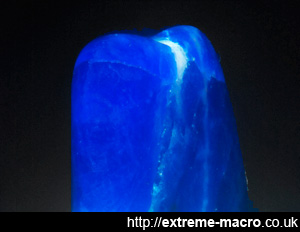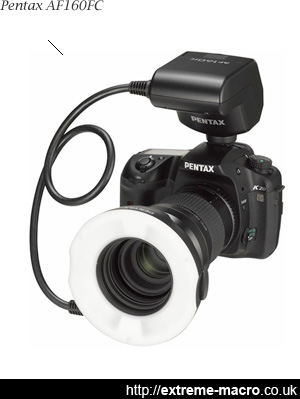Extreme Macro Flash
by Johan J Ingles-Le Nobel
Last updated August 31, 2017
Familiarisation with flash lighting is one of the challenges that the extreme macro photographer faces, but it is an excellent tool for both studio and field macro photography.

A highly reflective polished sodalite stone... but no reflections? Flash has a bad reputation for harsh photography because of specular reflections when used poorly, but by using the correct techniques such as cross polarisation and diffusion, flash photography can be very even and smooth.
Flash not only allows us to achieve extremely sharp photographs because of its short duration, but also enables us to photograph objects and places that should be too dark to make a decent photograph of. Flash is obviously invaluable in night macro.
Conquering your fear of flash and learning to use it like your right hand is one of the best things you can spend time on as a macro photographer. I started by learning about the manual mode on flash and using that, but eventually moved onto a TTL mode because it enables rear sync, which prevents flash ghosting.
Extreme Macro Studio
Conquering your fear of flash and learning to use it like your right hand is one of the best things you can spend time on as a macro photographerIf you're looking for a good project to do during the Winter when there's not much macro to be shot outside, consider building yourself an extreme macro studio. An extreme macro studio doesn't need to be expensive or fancy but there are certain widgets, supports, clamps and leads that you will want to ponder as you set off on this exercise. You don't need to buy the most expensive bits either - stages tend to be the major part but there is other specialised studio gear that is also useful.
Lighting Techniques
Pentax AF160FC ringflash. Definitely expensive, but its twin semi-toroidal flashtubes, variable light ratios, focus LEDs and PTTL functionality make it outstanding for extreme macro, better than a flash with diffuser.
Lighting is lighting, regardless of whether the specimen is six foot tall or a sixth of an inch, the ideas are the same. The studio techniques section concerns itself with controlling lighting, through the use of studio tools and through its direction. Barn doors, beauty dishes, flags snoots, crates, honeycombs and more are all explored there.
Flash Modes
Today's modern flashes offer a range of flash modes for photography, and regardless of what manufacturers say, they don't all work that well for macro or extreme macro, because of the short distances involved.
Nonetheless some of the modes do make your life easier as an extreme macro photographer and all such flash mode discussions are covered in the flash modes section.
Flash Challenges
Getting great extreme macro results using flash does take a bit of learning, and this can be quite daunting as the flash universe is filled with technicalities and challenges that most photographers have no need to be aware of.
Lighting is lighting, regardless of whether the specimen is six foot tall or a sixth of an inch, the ideas are the sameSome of these flash problems and issues are somewhat obscure, for example what could be the cause of that curious shadow fringe that you might be seeing on some of your flash photography, but others are much more mundane, for example what's behind the colour casts on your flash photography.
Flash Reviews
Flash units come at many different pricepoints but for extreme macro you should really look for some basics. Applying what's contained in the reviews of the Pentax flash models that I use might hopefully give you the knowledge that you need to avoid expensive mistakes.
Related Articles






